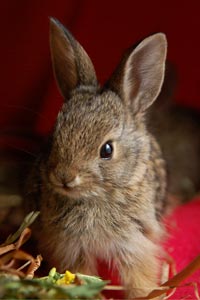Baby cottontail bunny rehabiliation

When a little cottontail arrived at Wild Friends, it was clear he was in trouble. Carmen Smith, Wild Friends manager who also is a state and federally licensed wildlife rehabilitator, saw immediately that the baby rabbit was unresponsive and paralyzed with fear.
Cottontail rabbit attacked by dog
He’d been attacked by a dog in the area, and though there were no visible wounds, Carmen’s past experience with similar incidents told her internal injuries would be likely. Dogs sometimes view small rabbits and other wildlife as something to chase and play with, but when their prey drive kicks in, it can cause real harm.
While Carmen kept the baby cottontail quiet, Best Friends vet Dr. Tara Timpson prescribed a homeopathic remedy often used to treat fear and bruising; and after just three hours, he was looking bright again and a lot happier. When someone reaching into his enclosure caused him to make grunting sounds and to try and get away, it was an excellent sign that he was feeling better.
A desert diet for wild bunny
 Though tiny, he was already weaned and able to eat solid food by himself. He was fed a special mixture of the right kinds of leafy greens, hay and grass — all food normally found out in the wild. Contrary to popular belief, western cottontails, which are native to the deserts of the Southwest, cannot eat carrots or the kinds of vegetables people generally eat. “People food” has too much sugar and other ingredients that adversely affect rabbits’ digestive systems; desert animals, like all wildlife, are designed to eat what’s there in the wild.
Though tiny, he was already weaned and able to eat solid food by himself. He was fed a special mixture of the right kinds of leafy greens, hay and grass — all food normally found out in the wild. Contrary to popular belief, western cottontails, which are native to the deserts of the Southwest, cannot eat carrots or the kinds of vegetables people generally eat. “People food” has too much sugar and other ingredients that adversely affect rabbits’ digestive systems; desert animals, like all wildlife, are designed to eat what’s there in the wild.
Four other rescued baby cottontails as neighbors
Even though the tiny cottontail lost weight for the first few days of recovery, by day four he was gaining weight. Feeling livelier, he was well enough to be moved to an enclosure next to a litter of four other rescued baby cottontails, where he could watch his new neighbors.
When he’s well enough, he’ll be released in good cottontail habitat, far away from any dogs. Release time will be later in the morning, to avoid the pre-dawn hours, when predators are most active. That will give him the whole day to get used to his new surroundings and to find a place to settle down for the night. He’ll enjoy sunny days back out in the wild.
If you come across a small cottontail ...
If you come across a cottontail caught by a dog or a cat, especially if there is the appearance of injury, the rabbit should be taken immediately to a licensed wildlife rehabilitator. Injured wildlife need special expert care, so please don’t try to care for the animal yourself. If your cat or dog catches a cottontail, even if there’s no sign of external injury, take it to a rehabilitator, because even if they aren’t visible, internal injuries are almost always present.
If you are concerned about a really tiny baby cottontail who isn’t injured but seems to be alone, it’s the size of the rabbit that determines if the animal needs help. A cottontail the size of a medium-sized apple is fully weaned, self-sufficient and doesn’t need help. If the bunny is smaller and out of the den, something may have happened to the mother, so there may be a need for rescue. You can find a licensed rehabilitator in your area by searching online.
Learn more about how Best Friends helps local wildlife at Wild Friends.
Photos by Best Friends staff